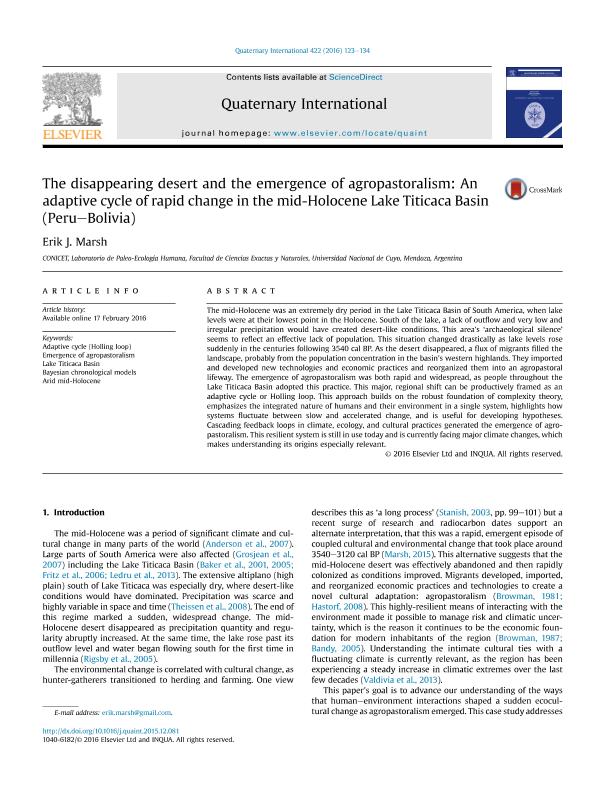Mostrar el registro sencillo del ítem
dc.contributor.author
Marsh, Erik Johnson

dc.date.available
2020-03-19T18:48:20Z
dc.date.issued
2016-11
dc.identifier.citation
Marsh, Erik Johnson; The disappearing desert and the emergence of agropastoralism: An adaptive cycle of rapid change in the mid-Holocene Lake Titicaca Basin (Peru–Bolivia); Pergamon-Elsevier Science Ltd; Quaternary International; 422; 11-2016; 123-134
dc.identifier.issn
1040-6182
dc.identifier.uri
http://hdl.handle.net/11336/100319
dc.description.abstract
The mid-Holocene was an extremely dry period in the Lake Titicaca Basin of South America, when lake levels were at their lowest point in the Holocene. South of the lake, a lack of outflow and very low and irregular precipitation would have created desert-like conditions. This area's ‘archaeological silence’ seems to reflect an effective lack of population. This situation changed drastically as lake levels rose suddenly in the centuries following 3540 cal BP. As the desert disappeared, a flux of migrants filled the landscape, probably from the population concentration in the basin's western highlands. They imported and developed new technologies and economic practices and reorganized them into an agropastoral lifeway. The emergence of agropastoralism was both rapid and widespread, as people throughout the Lake Titicaca Basin adopted this practice. This major, regional shift can be productively framed as an adaptive cycle or Holling loop. This approach builds on the robust foundation of complexity theory, emphasizes the integrated nature of humans and their environment in a single system, highlights how systems fluctuate between slow and accelerated change, and is useful for developing hypotheses. Cascading feedback loops in climate, ecology, and cultural practices generated the emergence of agropastoralism. This resilient system is still in use today and is currently facing major climate changes, which makes understanding its origins especially relevant.
dc.format
application/pdf
dc.language.iso
eng
dc.publisher
Pergamon-Elsevier Science Ltd

dc.rights
info:eu-repo/semantics/openAccess
dc.rights.uri
https://creativecommons.org/licenses/by-nc-sa/2.5/ar/
dc.subject
ADAPTIVE CYCLE (HOLLING LOOP)
dc.subject
ARID MID-HOLOCENE
dc.subject
BAYESIAN CHRONOLOGICAL MODELS
dc.subject
EMERGENCE OF AGROPASTORALISM
dc.subject
LAKE TITICACA BASIN
dc.subject.classification
Arqueología

dc.subject.classification
Historia y Arqueología

dc.subject.classification
HUMANIDADES

dc.subject.classification
Geociencias multidisciplinaria

dc.subject.classification
Ciencias de la Tierra y relacionadas con el Medio Ambiente

dc.subject.classification
CIENCIAS NATURALES Y EXACTAS

dc.title
The disappearing desert and the emergence of agropastoralism: An adaptive cycle of rapid change in the mid-Holocene Lake Titicaca Basin (Peru–Bolivia)
dc.type
info:eu-repo/semantics/article
dc.type
info:ar-repo/semantics/artículo
dc.type
info:eu-repo/semantics/publishedVersion
dc.date.updated
2020-03-18T20:38:06Z
dc.journal.volume
422
dc.journal.pagination
123-134
dc.journal.pais
Estados Unidos

dc.description.fil
Fil: Marsh, Erik Johnson. Universidad Nacional de Cuyo. Facultad de Ciencias Exactas y Naturales. Laboratorio de Paleoecología Humana; Argentina. Consejo Nacional de Investigaciones Científicas y Técnicas. Centro Científico Tecnológico Conicet - Mendoza; Argentina
dc.journal.title
Quaternary International

dc.relation.alternativeid
info:eu-repo/semantics/altIdentifier/doi/http://dx.doi.org/10.1016/j.quaint.2015.12.081
dc.relation.alternativeid
info:eu-repo/semantics/altIdentifier/url/https://www.sciencedirect.com/science/article/abs/pii/S1040618215300653
Archivos asociados
